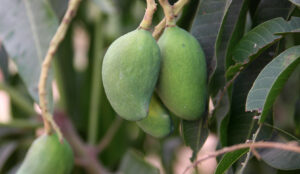Mango – Mangifera Indica

Mango, whose botanical name is Mangifera indica, is an evergreen tree, native to southern Asia, now naturalized in most of the warm areas of the world, from Australia to Latin America, from Africa to the warmer areas of the Mediterranean . It has a fairly rapid development, and within a few years it can reach 20-25 m in height, with a short stem and enlarged and rounded crown; Mangoes are the most cultivated and consumed fruits in the world, for this reason there are hundreds of cultivars and hybrids; the most common varieties have small fruits, with yellow and slightly fibrous pulp; however, there are varieties with compact pulp and larger fruits. The fruits are also used to prepare jams or sweets of various kinds; in Asia there are many mango-based recipes, both sweet and savory. Since mango fruits are grown in much of the globe, it is possible to find them on the market practically throughout the year.
GROUND
MANGO is not demanding about the type of soil in which to grow, although it is essential to prefer rich and deep soils, where they can easily sink their root system; to obtain healthy and vigorous trees it is necessary to plant them in a very well drained soil.
Mangifera indica plants are grown in a sunny or semi-shady place; they can also be cultivated in places where the winters are quite harsh, provided that the frosts are short and of slight entity, in this case, however, they generally do not bear fruit and have a very limited development, remaining the size of large shrubs.
The minimum recommended temperature is 5-7 ° C.
FIORI E FRUTTI
The small, pinkish-white flowers with a pleasant lily of the valley scent are gathered in panicle inflorescences 10-40 centimeters long. The fruits can vary in size depending on the cultivar.The pulp is yellow, quite fibrous and compact, very juicy and sweet in ripe fruits, it is sour in the fruits that are still green, it is consumed after having deprived the fruits of the thick peel.
USE AND HEALTHCARE CONTENT
Mangoes are widely used for their very pleasant taste and great organoleptic properties. In the kitchen, this fruit can be used in many recipes: in first courses, second courses paired with fish, in desserts, fruit salads and centrifuged. Undoubtedly the best way to eat it is to enjoy it fresh, peeled and cut into pieces or with sugar and lemon. The fruit of the mango is rich in nutrients, especially the pulp is rich in fiber, vitamin C, vitamin B6, vitamin K, and other nutrients such as potassium, copper. The peel of the mango contains pigments that can have antioxidant properties, including carotenoids, which can counteract the action of free radicals in various pathological processes, as has been shown by research. The nutrient and chemical content appears to vary between cultivars. Up to 25 different carotenoids have been isolated from the mango pulp, the most present of which is beta-carotene, which is responsible for the yellow-orange pigmentation of the fruits of many mango species.
PRUNING AND COLTURAL CARE
Pruning is generally not done before the fourth year after planting. In “cold” climates it is advisable to eliminate the floral panicles of the first years to allow the plant to acquire vigor, if the plant must be kept at a contained size obviously the formation pruning is important.
Until the plant goes into production, fertilization can be done with fertilizer with a high nitrogen content; later it is better to fertilize with products with a high content of phosphorus and potassium;
Mangoes require watering only in the first few years.
The harvest of the fruits is done, in the case of domestic cultivation, at maturity. In this case the fruit easily detaches from the plant with a weak pull.
